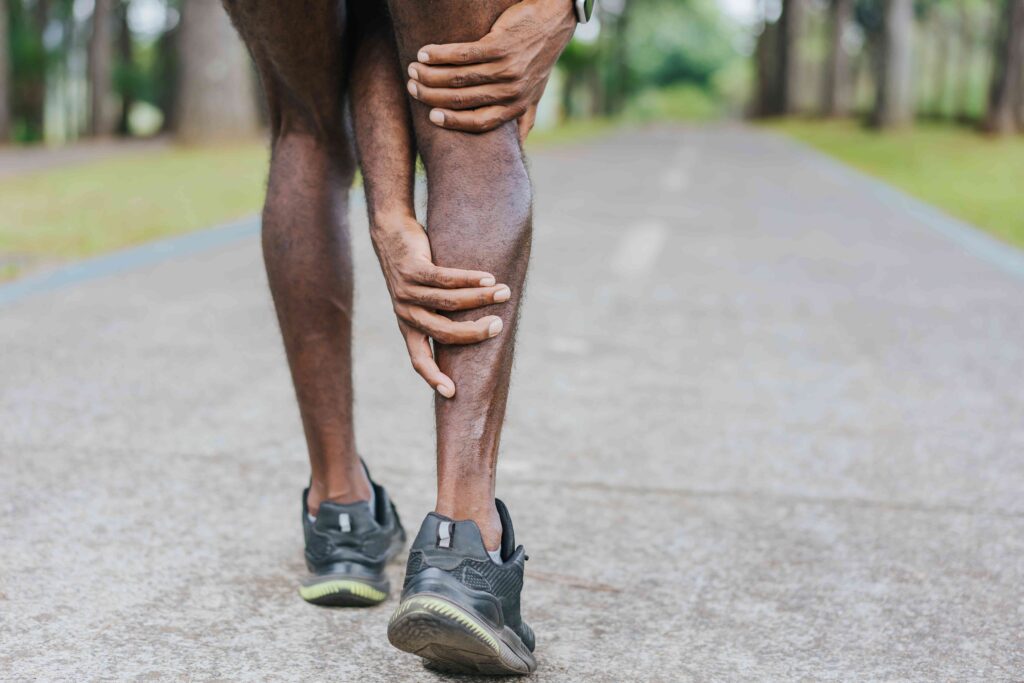:max_bytes(150000):strip_icc():format(jpeg)/Health-GettyImages-1462659310-6795a18edddc462ab9c3735eed39444c.jpg)
Muscle cramps are sudden, involuntary, painful contractions of one or more muscles in the body. Also called Charley horses or muscle spasms, they are typically short in duration and can last anywhere from a few seconds to several minutes.
Muscle cramps most commonly affect the back of the lower leg (calf), the back of the thigh (hamstrings), and the front of the thigh (quadriceps). Causes include muscle overuse during physical activity, certain health conditions, pregnancy, and some types of medications.
Anyone can experience muscle cramps, but the condition is more common in endurance athletes (such as marathon runners) and in older people who participate in activities that require a lot of physical exertion, such as walking or running for an extended period of time.
Muscle cramps can cause a painful, tense, tight feeling in the affected muscle. This sensation can last anywhere from a few seconds to several minutes.
When you have muscle cramps, you will experience contractions in the muscle. Contractions are a continuous tightening and relaxing of the muscles and may feel like a pulse.
Muscle cramps can affect an entire muscle group, an individual muscle, or certain muscle fibers. When touched, the area of the cramping feels like a knot.
Once the cramp has resolved, your muscle may still feel sore for a little while afterward.
Research shows that there is no one cause for muscle cramps. It’s generally believed that muscle cramps are more likely to occur when a muscle is injured or overused during physical activity, if you exercise while dehydrated, or if you have low levels of certain minerals such as calcium and sodium. There are also other possible causes.
1. Muscle Overuse or Injury
Muscles that are overused, strained, or injured from sports and other forms of physical activity can lead to muscle cramping. The overuse, straining, or injury causes a painful contraction of the muscles that happens during or immediately after the activity that caused it.
2. Dehydration
Not drinking enough water or fluids during exercise leads to dehydration, which is when you do not take in enough fluids to make up for the fluids your body is losing. Without enough fluids, your body can’t function normally. In some people, dehydration can trigger muscle cramping.
However, some research has found that electrically evoked cramping (muscle cramps that are electrically stimulated for the purpose of research) can still occur even after someone has consumed enough fluids during exercise. As these findings contradict other research that shows dehydration is a cause of muscle cramping, further study is needed.
3. Low Mineral Levels
Low blood levels of minerals such as sodium, potassium, and calcium can lead to an imbalance of electrolytes (key minerals your body needs to function properly), which may make a person more susceptible to muscle cramps.
Exercising in hot weather can also lead to a loss of minerals, salts, and fluids in the body, which can lead to muscle cramps.
4. Certain Medical Conditions
Certain medical conditions can lead to muscle cramping. These conditions include:
Kidney Failure
Up to 50% of people who undergo dialysis for kidney failure experience muscle cramping, especially in the lower limbs. During kidney failure, when the kidneys no longer function optimally, dialysis is a treatment that cleans the blood and removes excess fluid from the body. Dialysis-related cramps are linked to depression, sleep disorders, and a decrease in quality of life.
Diabetes
Cramps are common in people with diabetes, a chronic (long-lasting) condition that occurs when the body’s blood glucose (blood sugar) is too high. Diabetes-related cramping may occur due to nerve damage and because the peripheral nerves (the nerves outside the brain and spinal cord) are more easily activated by certain stimuli. Cramping is more common in people with type 2 diabetes (about 80%) than type 1 diabetes (about 60%).
Hypothyroidism
Hypothyroidism (an underactive thyroid) can lead to hypothyroid myopathy, a muscle disease characterized by painful muscle cramps, stiffness, and weakness around the hips and sometimes the shoulders.
Heart Failure
Heart failure occurs when the heart can’t pump enough oxygen-rich blood throughout the body. A lack of proper blood supply can negatively affect other organs, including muscles. Common symptoms of heart failure include shortness of breath, trouble breathing when lying down, and swelling of the extremities and stomach.
Muscle cramping is another symptom—specifically leg cramps that come on at night, known as nocturnal leg cramps. These nighttime leg cramps mainly affect the calf and can affect sleep quality.
Depression
Depression causes a persistent, overwhelming feeling of sadness and loss of interest in activities. The mood disorder can also have physical symptoms, as well, including digestive issues and headaches. Another physical symptom that has been linked to depression is nocturnal leg cramps.
5. Certain Medications
Certain types of medications can increase the risk of muscle cramps. These medications include diuretics (medications that remove excess fluids from the body), pseudoephedrine (a decongestant), beta-blockers (drugs that lower heart rate and reduce blood pressure), and statins (prescription drugs that lower cholesterol levels in the blood).
6. Pregnancy
Muscle cramps are a common symptom experienced by about 50% of people who are pregnant, particularly during the last three months of pregnancy and during the nighttime.
Research suggests muscle cramps during pregnancy could be due to a change in neuromuscular function, peripheral nerve compressions, weight gain, increased muscle activity in the lower limbs, mineral fluctuations, and inadequate blood flow to the muscles.
Less Common Causes
Several other health conditions and biological factors can also cause muscle cramps. Less common causes include:
- Nerve compression: When irritation or excess pressure occurs to the nerves outside the brain and spinal cord, a pinched (compressed) nerve can result and lead to muscle spasms.
- Peripheral artery disease (PAD): PAD is a condition characterized by the narrowing of the inside of the peripheral arteries, which transport blood away from the heart to other parts of the body. The most common form is lower-extremity PAD, marked by reduced blood flow in the legs and feet. Symptoms include leg or hip cramping, aching, and discomfort while walking or climbing stairs. The pain usually disappears after about 10 minutes of rest but can return with movement.
- Cirrhosis: This severe, permanent scarring of the liver significantly reduces liver function. About 88% of people with cirrhosis experience muscle cramps. The reason for the connection between cirrhosis and an increase in muscle cramps is unknown.
While most cases of muscle cramps resolve on their own, there are certain characteristics of a cramp or accompanying symptoms that could indicate other health problems involving circulation, metabolism, hormones, nerves, medications, or nutrition. If you experience any of the below symptoms, see a healthcare provider for medical care:
- Severe muscle cramps
- Frequent muscle cramps
- Muscle cramps that don’t improve with increased intake of fluids and frequent stretching
- Muscle cramps that last a long time
- Swelling, redness, warmth, or muscle weakness that occurs alongside muscle cramps
A healthcare provider can assess your symptoms and recommend an appropriate treatment. Diagnostic tests that may be ordered include blood tests to check kidney function, thyroid function, or levels of essential minerals such as calcium, potassium, and magnesium.
Muscle cramps usually resolve on their own, but if they persist or become more frequent, some treatments can help. These include the following:
- Gently massage or stretching the affected muscle
- Drink more fluids if you are dehydrated
- Apply heat to tight muscles or applying ice to sore muscles
- Take non-steroidal anti-inflammatory medicines (NSAIDs), such as aspirin and Advil (ibuprofen) to help reduce soreness—or possibly other medications prescribed by your healthcare provider for severe cramping
Treatment depends on the potential cause of the cramp, so there’s no single treatment that can alleviate all cramps.
Muscle cramps can occur for a number of reasons, but there are ways to prevent cramps or help reduce recurrences. You can try doing the following:
- Do a light warm-up, such as running in place or walking for a few minutes, before stretching your muscles
- Stretch before taking part in any physical activity
- Stretch your muscles before going to sleep, especially if you are prone to getting leg cramps in the evening
- Stay hydrated—e.g., 3 cups (104 ounces) of water per day for men and 9 cups (72 ounces) of water per day for women
- Consider consuming sports drinks to replace lost electrolytes, which can lead to mineral imbalances or losses that cause muscle cramps
Muscle cramps are involuntary, sudden, and painful contractions of one or more muscles. Causes include dehydration, mineral loss, muscle overuse or injury during exercise, and pregnancy.
Most muscle cramps resolve on their own within several minutes, but if they persist or cause other symptoms such as swelling, redness, or muscle weakness, see a healthcare provider.
Muscle cramps can be a nuisance, but there are ways to relieve the pain and discomfort. To help prevent muscle cramps, always warm up and stretch your muscles before physical activity, and stay sufficiently hydrated.













